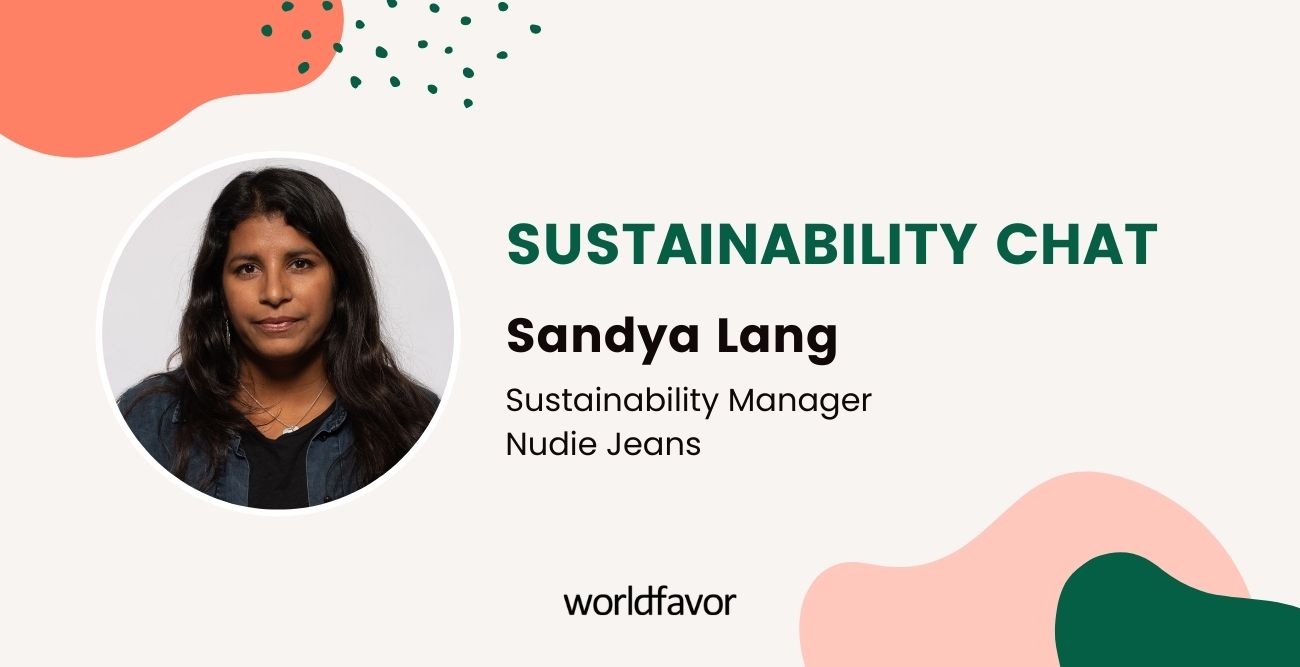Sustainability Chat with Sandya Lang, Sustainability Manager at Nudie Jeans
In our Sustainability Chat series, we speak with leaders and dreamers in the world of sustainability – picking their brains on what drives them, their experiences working in the field, plus all the best tricks of the trade.

This time we had the pleasure of meeting Sandya Lang, the Sustainability Manager of the Swedish denim brand Nudie Jeans and an expert in retail sustainability. Nudie Jeans is a leading example of a truly sustainable brand in the fashion retail industry, and we are super excited to get Sandya’s view on supply chain transparency and fashion retail sustainability. In this interview, Sandya shares how Nudie Jeans strives towards full transparency and gives her best advice to companies wanting to increase transparency in their supply chain.
You have over 10 years of experience working with sustainability – what changes have you noticed in the field since you started and how have people's/companies' attitudes towards sustainability changed?
– I started working with sustainability and textile/footwear in 2009, and since then I have seen a lot of changes. The attitude towards supply chain transparency has changed dramatically from being almost non-existing, to becoming close to common practice in today’s industry. The willingness and need for collaboration between industry partners and brands has increased a lot, as well as consumer awareness regarding sustainability. Today, customers expect brands to be sustainable.
At Nudie Jeans you strive to be transparent. Could you tell us a bit more about how you work with transparency?
– We started quite early on working practically with supply chain transparency by introducing the production guide in 2013. Before that, we made audits at all our suppliers and subcontractors in Italy, Portugal, Turkey and India, to be able to present the conditions at the supplier in the production guide online. We think transparency is about showing not only the name of the suppliers, but the actual conditions at the suppliers, both positive and less positive aspects, to be honest with the actual conditions.
From a business point of view, what key benefits do you see in being transparent throughout the supply chain?
– We see a lot of positive effects; a closer collaboration with our partners in the supply chain and collaboration opportunities with other brands who want to start producing at the same suppliers as we are using. It is also important from a risk management perspective as knowing your supply chain is key and the first step towards taking responsibility. If you do not know your supply chain, how can you be sure there are no non-compliances? We are proud of the suppliers we work with today and well aware about the challenges we have in the supply chain. It gives confidence to speak about the actual conditions in our supply chain and how we can collaborate to improve together.
What do you think it will take for companies to become more transparent in the future?
– Consolidation of the supply chain is important – if companies manage to reduce the number of suppliers and subcontractors it will be much easier to keep track and monitor, and then also be transparent about which suppliers they use. You can also discuss what transparency means in the fashion industry – is it to list the suppliers you work with, or is it to inform about the conditions for the workers in the supply chain, the social and environmental impact of the garments made at those factories? Companies need to decide which level of transparency is possible to provide and be honest with that.
What is your best piece of advice for companies who want to be more transparent – where should they start?
– Make sure the decision of becoming more transparent is well established within the company. Start consolidating the supply chain, maybe even reducing the garment collections, and discuss possible positive and negative effects it can bring. It might require the company to end supplier relationships if the supplier does not agree to be transparent, it might also need additional resources internally to monitor and keep track of the supply chain. But again, transparency in the supply chain is key for successful sustainability work, so just start! And then talk.
If you liked this Sustainability Chat and want to stay updated on our future guests, please subscribe to our newsletter. We can guarantee exhilarating chats with sustainability-profiles you don’t want to miss!
Related blog post you might like:
- Sustainability Chat With Frida Emilsson, co-founder and COO of Worldfavor
- Why Everyone’s Focusing on Supply Chain Transparency and What it Means
- How Supply Chain Visibility, Traceability, Transparency, and Mapping relate to each other





%20as%20the%20deadline%20approaches.%20Learn%20about%20compliance%20requirements%2c%20potential%20delays%2c%20and%20key%20updates..png)

